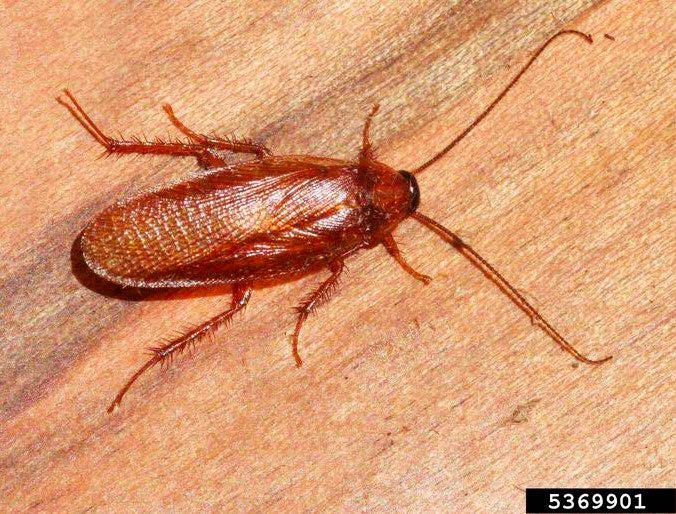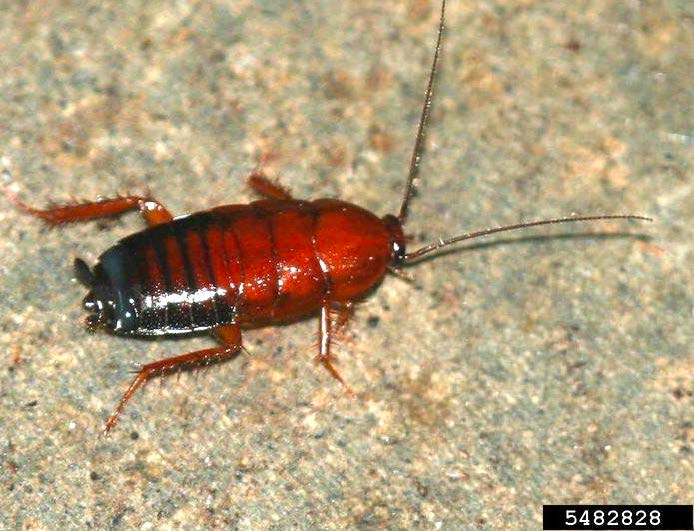Wood Cockroaches
ID
ENTO-426NP
Identification
Several species in the genus Parcoblatta are collectively known as the wood cockroaches or wood roaches. These species closely resemble each other and can be difficult to identify, but control measures for these insects are the same regardless of the species.
The bodies of adult wood cockroaches have an oval shape and are flattened, allowing them to hide under tree bark or in tight crevices. Their body color ranges from a light reddish-brown to dark brown. The outer edge of the “shield” immediately behind the head is paler in color; these pale edges continue onto the wings of the adult males. Wood cockroaches have long antennae and legs; the legs have distinct spines along their length. They generally measure about 19-26 mm (0.75 to 1.0”) long, depending on the species. Wood cockroaches are sometimes mistaken for American cockroaches.
Adult males and females look very different. Adult males have wings that cover the abdomen and can fly (Fig. 1). Adult females may have short wings or only small wingpads and are flightless (Fig. 2). Their bodies are shiny and are generally darker in color than the males. Adult males are usually bigger than the females.
Blattodea: Ectobiidae, Parcoblatta spp.
Habitat
Wood cockroaches are native insects commonly found throughout Virginia and the United States. They are typically found in leaf litter and rotting wood, which provides the decaying organic matter they eat and the high moisture levels they require for survival. They may also be found in wet mulch, gutters clogged with leaves, under loose tree bark, in piles of firewood, under loose wood siding, and similar sites.


Sometimes wood cockroaches are found in damp garages or basement, woodsheds, or on decks under tree canopies. Adult males may be attracted to bright porch lights at night. Houses built in heavily wooded areas may have more wood cockroaches than houses sited away from wooded areas.
Life Cycle
Wood cockroaches have an incomplete life cycle consisting of egg, nymphal, and adult stages. During the warm months, adult females lay their eggs encased in a protective egg capsule. They may carry this capsule on their abdomen for some time before depositing it. The wingless nymphs look like smaller versions of the adult females. Nymphs overwinter in protected areas, such as under loose tree bark, and molt into the adult stage the following summer. Adults live for several months before dying. Wood cockroaches generally take about a year, but sometimes longer, to complete their life cycle.
Description of Damage
Wood cockroaches sometimes wander indoors, but they die in a matter of days due to the lack of moisture. Sometimes they are accidently carried inside with firewood. They may be seen blundering around during the day when most species of cockroaches hide. While they may be a nuisance, wood cockroaches are harmless and are unable to survive or reproduce indoors because of the reduced humidity inside houses.
Control
Good home maintenance can limit wood cockroaches from invading a house by reducing the places where they can enter. Check that window seals and door sweeps are in good condition, and that window and door screens fit tightly. Clean leaf litter from gutters and roofs. Seal any exterior cracks and crevices around windows and doors, or in the foundation. Be sure to seal gaps around places where wiring and pipes enter homes.
Do not store firewood beside a house or on a front porch. Shake or knock firewood off before bringing inside to dislodge any insects on it. Reduce and remove any clutter, dead stumps, or any rotten wood in the yard that may harbor wood cockroaches. Don’t allow mulch or leaf litter to build up near basement doors or windows, or around the foundation. Turn off outdoor lights when not needed, or use yellow lights that are less attractive to nocturnal insects than white lights. Dehumidifiers can reduce indoor humidity levels in basements.
Wood cockroaches found indoors can easily be killed using a fly swatter, a vacuum, or an aerosol insecticide as needed. Foundation or perimeter treatments with residual insecticides are generally unnecessary.
Virginia Cooperative Extension materials are available for public use, reprint, or citation without further permission, provided the use includes credit to the author and to Virginia Cooperative Extension, Virginia Tech, and Virginia State University.
Virginia Cooperative Extension is a partnership of Virginia Tech, Virginia State University, the U.S. Department of Agriculture (USDA), and local governments, and is an equal opportunity employer. For the full non-discrimination statement, please visit ext.vt.edu/accessibility.
Publication Date
March 4, 2021



